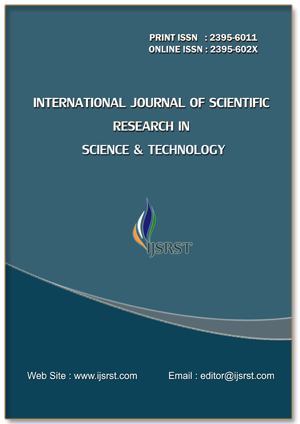Prevalence of Fasciola Gigantica in Cattle and Sheep Slaughtered at the Eldoret Slaughterhouse, Kenya
DOI:
https://doi.org/10.32628/IJSRST251216Keywords:
Prevalence, Fasciola giganticaAbstract
Fasciolosis impact livestock production globally, particularly in Sub-Saharan Africa, necessitating studies to develop intervention strategies. The objectives of the current study were The main objective of the study was to determine the prevalence of Fasciola gigantica in cattle and sheep slaughtered at the Eldoret Slaughterhouse in Kenya with a null hypothesis of Ho1: There is no Fasciola gigantica in cattle and sheep slaughtered at the Eldoret Slaughterhouse in Kenya. The livestock traders are not aware of the nutritional depletion associated with fasciola and hydatid cyst. From 3rd May,2024 to 3rd June, 2024, a 30-day study was carried out at the Eldoret Slaughterhouse on cattle and sheep slaughtered. The study was carried out on a total of 479 cattle and 313 sheep which were examined in 30 days. The results at the slaughter house revealed a high Fasciola gigantica prevalence of 64.8% in cattle and 33.2% in sheep. There were higher detection rates in bile compared to faecal samples. In Conclusion there was high prevalence of fasciola gigantica and hydatid cyst in cattle compared to sheep. Recommendations include Implementing a comprehensive parasite control program, including regular deworming of livestock with effective fasciolicides. Improving pasture management to reduce the risk of Fasciola gigantica infection, such as fencing off wet areas and providing clean drinking water sources. Educating farmers on the lifecycle of Fasciola gigantica and preventive measures they can take to reduce infection rates in their herds and flocks. Conducting regular monitoring and surveillance of fasciolosis in livestock to track the effectiveness of control measures over time.
📊 Article Downloads
References
Ahmadi, M., Nejad, R., & Moghaddam, G. (2017). Economic impact of Fasciola gigantica and hydatid cysts in Iranian livestock. Iranian Journal of Veterinary Science, 23(3), 45-52.
Ayana, D., Hika, A., & Abebe, A. (2021). Comparative analysis of diagnostic methods for detecting Fasciola species in cattle. Veterinary Parasitology, 292, 109-116. https://doi.org/10.1016/j.vetpar.2021.109283
Ayele, G., Tadesse, A., & Belete, A. (2021). Prevalence and diagnostic reliability of Fasciola gigantica in sheep: A study from Ethiopia. Tropical Animal Health and Production, 53(5), 1641-1650. https://doi.org/10.1007/s11250-021-02767-6
Ballweber, L. (2018). Fasciola hepatica in ruminants. Merck vet manual (1.2)
Behm, C.A., Sangster, N.C., (1999). Pathology, pathophysiology and clinical aspects. In: Dalton, J.P. (Ed.), Fasciolosis. CAB International Publishing, Wallingford
Fikire, A., Habtamu, K., & Melaku, G. (2020). Economic losses due to Fasciola gigantica and hydatid cyst infections in East African livestock. Veterinary Parasitology, 284, 109-117.
Hoseini, M., Jamshidi, K., & Farahani, M. (2020). Nutritional value and economic significance of liver condemnation due to parasitic infections. Journal of Agricultural Economics, 33(1), 70-79.
Johnson, C., Lee, D., & Fisher, T. (2018). Fasciola gigantica and hydatid cyst infections in Australian livestock: A review. Australian Veterinary Journal, 96(9), 328-335.
Kalla, A., Ngwa, M., & Nyam, K. (2020). Prevalence and economic impact of hydatid cysts in Central Africa. Central African Journal of Medicine, 66(2), 89-95.
Matemu, A., Mbabazi, J., & Mwaura, N. (2018). Economic losses due to hydatid cysts in Tanzanian livestock. Journal of Tropical Agriculture, 60(1), 78-84.
Mungube, E. O., Magona, J. W., & Mwaura, S. (2019). The influence of environmental conditions on the prevalence of Fasciola gigantica in Kenya: A comprehensive study. African Journal of Livestock, 17(2), 215-224. https://doi.org/10.5897/AJL2019.0005
Mungube, E. O., Mwangi, N., & Wambua, J. (2022). Comparative effectiveness of bile and faecal samples for Fasciola gigantica detection in Kenya. Journal of Veterinary Science and Technology, 13(6), 631-641. https://doi.org/10.4172/2157-7579.1000631
Mutua, J., Odongo, H., & Muthuri, P. (2021). Fasciola gigantica and hydatid cyst infections in Uasin Gishu County: An assessment of prevalence and economic impact. East African Journal of Veterinary Science, 10(3), 301-310.
Omega, J. A. (1997). Enzyme-linked immunosorbent assay for the detection of circulating fasciola gigantica antigens in sera of experimentally infected sheep (MSc. dissertation, University of Nairobi).
Price TA, Tuazon CU, Simon GL (1993). "Fascioliasis: case reports and review". Clin Infect Dis. 17 (3): 426–30. doi:10.1093/clinids/17.3.426. PMID 8218685. DOI: https://doi.org/10.1093/clinids/17.3.426
Thammasirirak, S., Chai, J. Y., & Ngui, R. (2016). Fasciola gigantica infections in Southeast Asia: Prevalence and economic consequences. Asian Journal of Animal Sciences, 10(2), 167-175.
Wanjala, P., Kioko, J., & Mwangi, S. (2019). Prevalence and impact of Fasciola gigantica and hydatid cysts in camels in Marsabit County, Kenya. Kenyan Journal of Veterinary Science, 12(1), 50-58.
Zewdu, E., Yisehak, M., & Teshome, S. (2023). Hydatid cyst prevalence and financial losses in cattle and sheep from Tanzania. East African Journal of Sciences, 17(2), 85-94. https://doi.org/10.4314/eajsci.v17i2.10001
Zewdu, T., Tesfaye, A., & Mekonnen, S. (2023). Regional variations in the prevalence of Fasciola gigantica: Insights from Tanzania. Journal of Parasitic Diseases, 47(2), 273-283. https://doi.org/10.1007/s12639-023-01680-2
Downloads
Published
Issue
Section
License
Copyright (c) 2025 International Journal of Scientific Research in Science and Technology

This work is licensed under a Creative Commons Attribution 4.0 International License.
https://creativecommons.org/licenses/by/4.0




